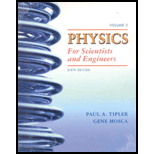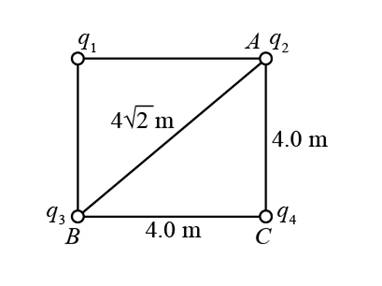
Concept explainers
(a)
The electrostatic potential energy of the system when all of the charges are negative.
(a)
Answer to Problem 68P
The electrostatic potential energy of the system when all of the charges are negative is
Explanation of Solution
Given Data:
The charge on each particle is
The side of a square is
Formula used:
The expression for the work required to assemble the system of charges which is equal to the potential energy of the system is given as,
Calculation:

Figure (1)
The electrostatic potential energy of the system is calculated as,
Conclusion:
Therefore, the electrostatic potential energy of the system when all of the charges are negative is
(b)
The electrostatic potential energy of the system when three of the charges are positive and one of the charge is negative.
(b)
Answer to Problem 68P
The electrostatic potential energy of the system when three of the charges are positive and one of the charge is negative is zero.
Explanation of Solution
Given Data:
The charge on three particles is
The charge on fourth particle is
The side of a square is
Formula used:
The expression for the work required to assemble the system of charges which is equal to the potential energy of the system is given as,
Calculation:
The electrostatic potential energy of the system is calculated as,
Conclusion:
Therefore the electrostatic potential energy of the system when three of the charges are positive and one of the charge is negative is zero.
(c)
The electrostatic potential energy of the system when two adjacent corners are positive and other two are negative
(c)
Answer to Problem 68P
The electrostatic potential energy of the system when two adjacent corners are positive and other two are negative is
Explanation of Solution
Given Data:
The charge on first particle is
The charge on second particle is
The charge on third particle is
The charge on fourth particle is
The side of a square is
Formula used:
The expression for the work required to assemble the system of charges which is equal to the potential energy of the system is given as,
Calculation:
The electrostatic potential energy of the system is calculated as,
Conclusion:
Therefore the electrostatic potential energy of the system when two adjacent corners are positive and other two are negative is
(d)
The electrostatic potential energy of the system when the charges at two opposite corners are positive and other two are negative.
(d)
Answer to Problem 68P
The electrostatic potential energy of the system when the charges at two opposite corners are positive and other two are negative is
Explanation of Solution
Given Data:
The charge on first particle is
The charge on second particle is
The charge on third particle is
The charge on fourth particle is
The side of a square is
Formula used:
The expression for the work required to assemble the system of charges which is equal to the potential energy of the system is given as,
Calculation:
The electrostatic potential energy of the system is calculated as,
Conclusion:
Therefore, the electrostatic potential energy of the system when the charges at two opposite corners are positive and other two are negative is
Want to see more full solutions like this?
Chapter 23 Solutions
Physics for Scientists and Engineers, Vol. 3
- A parallel-plate capacitor with capacitance 5.0F is charged with a 12.0-V battery, after which the battery is disconnected. Determine the minimum work required to increase the separation between the plates by a factor of 3.arrow_forwardA proton is fired from very far away directly at a fixed particle with charge q = 1.28 1018 C. If the initial speed of the proton is 2.4 105 m/s, what is its distance of closest approach to the fixed particle? The mass of a proton is 1.67 1027 kg.arrow_forwardIf a negatively charged particle is placed at rest in an electric potential field that increases in the positive x-direction, will the panicle (a) accelerate in the positive x-direction, (b) accelerate in the negative x-direction, or (c) remain at rest?arrow_forward
- Check Your Understanding Is the electrical potential energy of two point charges positive or negative if the charges are of the same sign? Opposite signs? How does this relate to the work necessary to bring the charges into proximity from infinity?arrow_forwardWould electric potential energy be meaningful if the electric field were not conservative?arrow_forwardTwo particles each with charge +2.00 C are located on the x axis. One is at x = 1.00 m, and the other is at x = 1.00 m. (a) Determine the electric potential on the y axis at y = 0.500 m. (b) Calculate the change in electric potential energy of the system as a third charged particle of 3.00 C is brought from infinitely far away to a position on the y axis at y = 0.500 m.arrow_forward
- A point charge of q=50108 C is placed at the center of an uncharged spherical conducting shell of inner radius 6.0 cm and outer radius 9.0 cm. Find the electric potential at (a) r = 4,0cm, (b) r = 8.0 cm, (c) r — 12.0 cm.arrow_forwardConsider a charge Q1(1+5.0C) fixed at a site with another charge Q2 (Charge +3.0C , mass 6.0g ) moving in die neighboring space, (a) Evaluate die potential energy of Q2 when it is 4.0 cm from Q1 (b) If Q2 starts from rest from a point 4.0 cm from Q1what will be its speed when it is 8.0 cm from Q1 ? (Note: Q1 is held fixed in its place.)arrow_forwardTwo particles, with charges of 20.0 nC and 20.0 nC, are placed at the points with coordinates (0, 4.00 cm) and (0, 4.00 cm) as shown in Figure P20.19. A particle with charge 10.0 nC is located at the origin. (a) Find the electric potential energy of the configuration of the three fixed charges. (b) A fourth particle, with a mass of 2.00 1013 kg and a charge of 40.0 nC, is released from rest at the point (3.00 cm, 0). Find its speed after it has moved freely to a very large distance away.arrow_forward
- Two very large metal plates are placed 2.0 cm apart, with a potential difference of 12 V between them. Consider one plate to be at 12 V, and the other at 0 V. (a) Sketch the equipotential surfaces for 0, 4, 8, and 12 V. (b) Next sketch in some electric field lines, and confirm that they are perpendicular to the equipotential lines.arrow_forwardTwo parallel plates 10 cm on a side are given equal and opposite charges of magnitude 5.0109 C. The plates are 1.5 mm apart. What is the potential difference between the plates?arrow_forwardCalculate the angular velocity of an electron orbiting a proton in the hydrogen atom, given the radius of the orbit is 0.5301010 m. You may assume that the proton is stationary and the centripetal force is supplied by Coulomb attraction.arrow_forward
 Principles of Physics: A Calculus-Based TextPhysicsISBN:9781133104261Author:Raymond A. Serway, John W. JewettPublisher:Cengage Learning
Principles of Physics: A Calculus-Based TextPhysicsISBN:9781133104261Author:Raymond A. Serway, John W. JewettPublisher:Cengage Learning College PhysicsPhysicsISBN:9781285737027Author:Raymond A. Serway, Chris VuillePublisher:Cengage Learning
College PhysicsPhysicsISBN:9781285737027Author:Raymond A. Serway, Chris VuillePublisher:Cengage Learning
 College PhysicsPhysicsISBN:9781305952300Author:Raymond A. Serway, Chris VuillePublisher:Cengage Learning
College PhysicsPhysicsISBN:9781305952300Author:Raymond A. Serway, Chris VuillePublisher:Cengage Learning Physics for Scientists and Engineers: Foundations...PhysicsISBN:9781133939146Author:Katz, Debora M.Publisher:Cengage Learning
Physics for Scientists and Engineers: Foundations...PhysicsISBN:9781133939146Author:Katz, Debora M.Publisher:Cengage Learning College PhysicsPhysicsISBN:9781938168000Author:Paul Peter Urone, Roger HinrichsPublisher:OpenStax College
College PhysicsPhysicsISBN:9781938168000Author:Paul Peter Urone, Roger HinrichsPublisher:OpenStax College





